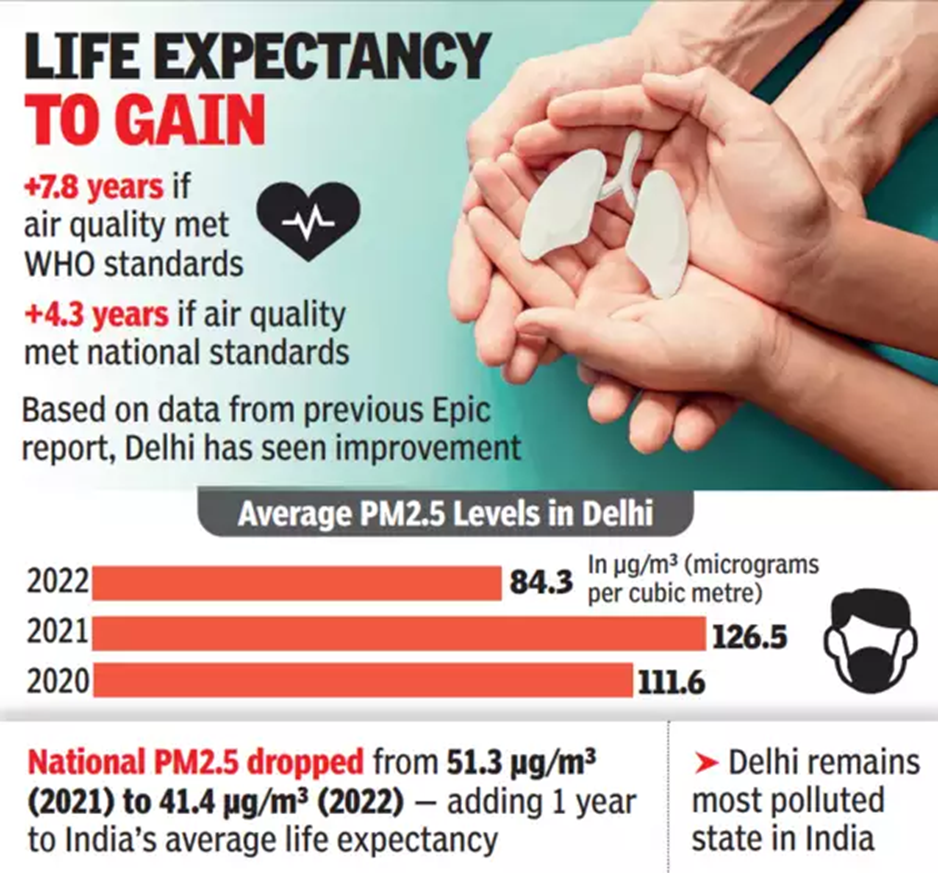- Courses
- GS Full Course 1 Year
- GS Full Course 2 Year
- GS Full Course 3 Year
- GS Full Course Till Selection
- Answer Alpha: Mains 2025 Mentorship
- MEP (Mains Enrichment Programme) Data, Facts
- Essay Target – 150+ Marks
- Online Program
- GS Recorded Course
- Polity
- Geography
- Economy
- Ancient, Medieval and Art & Culture AMAC
- Modern India, Post Independence & World History
- Environment
- Governance
- Science & Technology
- International Relations and Internal Security
- Disaster Management
- Ethics
- NCERT Current Affairs
- Indian Society and Social Issue
- NCERT- Science and Technology
- NCERT - Geography
- NCERT - Ancient History
- NCERT- World History
- NCERT Modern History
- NCERT Medieval History
- CSAT
- 5 LAYERED ARJUNA Mentorship
- Public Administration Optional
- ABOUT US
- OUR TOPPERS
- TEST SERIES
- FREE STUDY MATERIAL
- VIDEOS
- CONTACT US
Air Quality Life Index (AQLI) 2024
Air Quality Life Index (AQLI) 2024
31-08-2024

1. Why in News?
- The Energy Policy Institute at the University of Chicago (EPIC) has released the Air Quality Life Index (AQLI) for 2024.
- In India, over 40% of the population breathes air exceeding the annual PM2.5 standard of 40 µg/m³.
2. Key Findings of AQLI 2024:
- Impact on Life Expectancy: Reducing PM2.5 to WHO guidelines (5 µg/m³) could add 1.9 years to global life expectancy, totaling 14.9 billion life years worldwide.
- Comparison with Other Risks: Air pollution has a greater impact on life expectancy than smoking, heavy drinking, HIV/AIDS, and malnutrition.
- Distribution of Pollution: People in the most polluted areas breathe air six times more polluted than those in the cleanest regions, resulting in a 2.7-year reduction in life expectancy.
- Non-Compliance with Standards: 94 countries have PM2.5 standards; 37 do not meet their own guidelines. 158 countries have no standards at all.
- Potential Benefits: Achieving WHO pollution standards could increase life expectancy by 1.2 years globally.
3. Global Scenario:
-
US, China, Europe:
- US: 67.2% reduction in pollution since 1970, increasing life expectancy by 1.5 years.
- China: 41% reduction in pollution since 2014, extending life by 2 years.
- Europe: 30.2% reduction since 1998, adding 5.6 months to life expectancy.
-
South and Southeast Asia:
- 4% decline in PM2.5 levels since 2012.
- South Asia remains the most polluted region, contributing to 45% of global life years lost.
- In Myanmar, pollution reduces life expectancy by 2.9 years.
-
Africa:
- Central and West Africa’s PM2.5 concentration is 22.2 µg/m³, 4.4 times higher than WHO guidelines.
- This pollution reduces life expectancy by 1.7 years.
- Nigeria, Rwanda, and Ghana are making progress with new regulations.
-
West Asia:
- Middle East and North Africa (MENA) are emerging as new pollution hotspots, reducing life expectancy by 1.3 years.
- Qatar and Iraq are the most polluted countries in the region.
-
Latin America:
- PM2.5 levels increased by 4.8% from 2021 and 3% from 1998.
- Bolivia is the most polluted, and Guatemala’s pollution reduces life expectancy by 2.1 years.
- Cities like Bogotá, Mexico City, and Quito are implementing measures to reduce pollution.
4. India-Specific Findings:
-
Impact on Delhi:
- Cleaner air meeting WHO guidelines could increase Delhi's life expectancy by 7.8 years.
- Achieving India's national standard (40 µg/m³) could increase life expectancy by 4.3 years.
-
Current Air Quality:
- Delhi has an average PM2.5 level of 84.3 µg/m³ in 2022.
- India’s average PM2.5 level decreased from 49 µg/m³ over the last decade to 41.4 µg/m³ in 2022.
- Continued reduction could add 9 months to life expectancy.
-
Comparison with Other Health Risks:
- Particulate pollution reduces life expectancy by 3.6 years, compared to 1.6 years for malnutrition, 1.5 years for tobacco use, and 8.4 months for unsafe water and sanitation.
5. What is the Air Quality Life Index (AQLI)?
- The AQLI measures the impact of particulate air pollution on life expectancy.
- It translates long-term exposure to air pollution into its effect on life expectancy and shows how meeting air quality standards can improve health outcomes.
6. Strategies to Control Air Pollution:
- Prevention: Use less toxic materials, cleaner processes, and improved efficiency (e.g., BSVI engines).
- Clean Air Technology: Implement technologies like wet scrubbers, fabric filters, and electrostatic precipitators.
- Economic Incentives: Use emissions trading and caps for industries.
- Scrapping Old Vehicles: Removing end-of-life vehicles can reduce emissions by 15-20%.
- Work-from-Home: Encourage remote work during high pollution periods.
- Artificial Rain: Washes away airborne pollutants.
- Behavioral Change: Promote public transport, walking, and cycling.
7. Government Initiatives:
- SAFAR Portal: System for Air Quality and Weather Forecasting and Research.
- Air Quality Index (AQI): Measures and reports air quality levels.
- Graded Response Action Plan (for Delhi): A plan to address air pollution based on severity.
- New Commission for Air Quality Management: Oversees air quality regulations.
- National Air Quality Monitoring Programme (NAMP): Monitors air quality across India.
Conclusion:
Air pollution is a critical issue in India, significantly affecting life expectancy and public health. Although there have been improvements, continued and enhanced efforts are necessary to meet international guidelines and improve air quality, thus extending life expectancy and safeguarding public health.
Must Check: Best IAS Coaching In Delhi
UPSC Prelims Result 2024 Out: Expected Cut Off & Other Details, UPSC Prelims 2024 Answer with Explanation, Daily Prelims Quiz, Daily Current Affairs, MONTHLY CURRENT AFFAIRS TOTAL (CAT) MAGAZINE, Best IAS Coaching Institute in Karol Bagh, Best IAS Coaching Institute in Delhi, Daily Mains Question Answer Practice, ENSURE IAS UPSC Toppers, UPSC Toppers Marksheet, Previous Year Interview Questions, UPSC Syllabus




